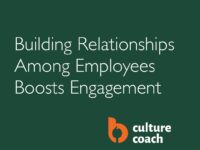Organizations today are dead-set on delivering exceptional customer experiences. However, not enough realize that in order to do so, they must fully understand the relationship between customer experience and employee experience.
There are countless reasons why an organization would want its customers to have great experiences. Without customers, of course, the business wouldn’t exist in the first place. Regardless of whether it’s a B2B or B2C transaction, when a customer feels they had a great experience with the company they receive goods or services from, it’s no secret what happens next.
Happy customers often become loyal customers. Loyal customers have a habit of spending more money on the business and recruiting like-minded consumers to do the same. It’s a virtuous cycle, but achieving it does not happen effortlessly.
In order for satisfied customers to become loyal customers (and promoters), the company must strategically prioritize consumer needs in every interaction. This is a function called “customer experience,” which leverages sophisticated and rigorous analytical techniques to optimize every single touchpoint of the consumer journey. Today, 89% of companies plan to compete primarily on the basis of delivering a differentiated customer experience.
The customer experience function is the byproduct of a shareholder capitalism framework that dictates organizations must prioritize the wealth of their owners first and foremost. Executives are expected to devote the company’s resources to shareholders first, customers second, and employees last. Strategizing for the customer experience is believed to be one of the most reliable ways to deliver long-lasting shareholder value.
Some executives and public figures, like The Virgin Group Founder Sir Richard Branson, have been outspoken in their belief that this is the wrong order of operations for company strategy. They say that it’s impossible to deliver a great customer experience if employees are actively deprioritized at best, and at worst relegated to second-class citizenship.
After all, employees are who the company entrusts to deliver that best-in-class customer experience. If the company doesn’t treat them well, why would they want to treat customers well?
Why we need to improve employee experience first
Nothing good can come from a disengaged workforce. When employees feel they can’t engage in their roles, performance declines, absenteeism rises, and the customer experience suffers. And if the company really is treating employees like an afterthought, the effects cascade from there. Talent churns fast—even for high-performing employees, and the company’s reputation, internally and externally, declines.
Disengagement has the potential to ravage the company’s customer experience and tarnish its brand—but it doesn’t have to be this way. Those who understand the important role employees play in this equation advocate for an alternative path: improve employee experience first, then focus on the rest.
The Virgin Group’s Branson even specifically proposes an inversion of the shareholder capitalism framework: employees first, customers second, shareholders third. His reasoning? Employees, when finally given the tools they need to succeed, no longer feel like an afterthought, and everyone winds up happy. Shareholders don’t even really come last in this equation. As one retail executive notes in Bersin by Deloitte’s 2017 Human Capital Trends report, “We now realize we had it backward. If we put employees first, they in turn take care of our customers, and they in turn take care of our shareholders.”
This ideology helped pave the way for a new business function called “employee experience.” Much like its customer experience counterpart, the employee experience function is dedicated to analyzing and understanding employees’ journeys with the company. The end goal for employee experience experts (who are often, but not always HR professionals) is to use this information to create positive and empowering employee-centric experiences every step of the way.
And yes, every step means every step, from before employees are formally employees to after they’ve become alumni of the organization. Recruiting, onboarding, training, talent development, performance feedback, advancement. Each stage cannot be ignored because the sum total of these experiences sets employees up for the successes that make them genuinely want to come to work.
Related: Employee Experience, Explained
The link between customer experience and employee experience is ‘undeniable’
What’s important to understand about employee experience is that it’s not a flavor of the week for people managers. It’s a holistic framework for understanding how employees experience their work. Specifically, we understand employee experience as made up of three primary domains:
- The Procedural Experience, or the systems and processes that make up the work we do.
- The Textural Experience, or the experiences provided by our work environments.
- The Emotional Experience, or the emotions we feel that help us understand and navigate our roles, and even influence our performance.
Our article “What is Employee Experience?” explores each domain above in detail. The bottom line is, when organizations account for and optimize the employee experience, the benefits pay forward to the customer experience, and frankly, the whole company.
Blake Morgan, a customer experience author, thought leader, and keynote speaker, calls the link between customer experience and employee experience “undeniable.” For Forbes, she reports that companies who lead customer experience have 60% more engaged employees, highlighting industry leaders like Zappos, GE, and Adobe.
“Your employees are often your most untapped resource when it comes to building powerful customer experiences,” Morgan writes.
Her husband, Jacob Morgan, is one of the early champions of employee experience. His book titled The Employee Experience Advantage examines the efforts of organizations that dedicate strategic resources to improve employee experience. On the whole, he found these companies were four times more profitable and had twice the average revenue of less “experiential” competitors. They are also on average 25% smaller in size, which Morgan says “suggests higher levels of productivity and innovation.”
Like his wife, Morgan also found a meaningful relationship between customer experience and employee experience. Experiential companies were listed twice as often in the American Customer Satisfaction Index, suggesting employee-first strategy may just be the way to deliver world-class customer experiences.
Finally, a report from the Temkin Group illustrates key behaviors that result from great employee experiences on a more granular level. The firm found that these employees are more likely to:
- Recommend the company’s products and services to people who need them.
- Stay late at work if something needs to be done after standard work hours.
- Do something good for the company, even if it is not expected of their role.
- Make recommendations about improvements the company can make.
- Recommend friends or relatives apply for jobs with the company.
In sum, customer experience and employee experience go hand-in-hand. When companies choose to improve employee experience, it motivates employees to pay forward their experiences with improvements at the customer level. To quote Branson:
“An exceptional company is the one that gets all the little details right. And the people out on the front line, they know when things are not going right and they know when things need to be improved. And if you listen to them you can soon improve all those niggly things which turns an average company into an exceptional company.”



 4 min
4 min




